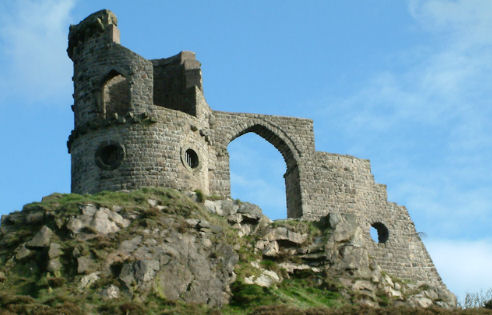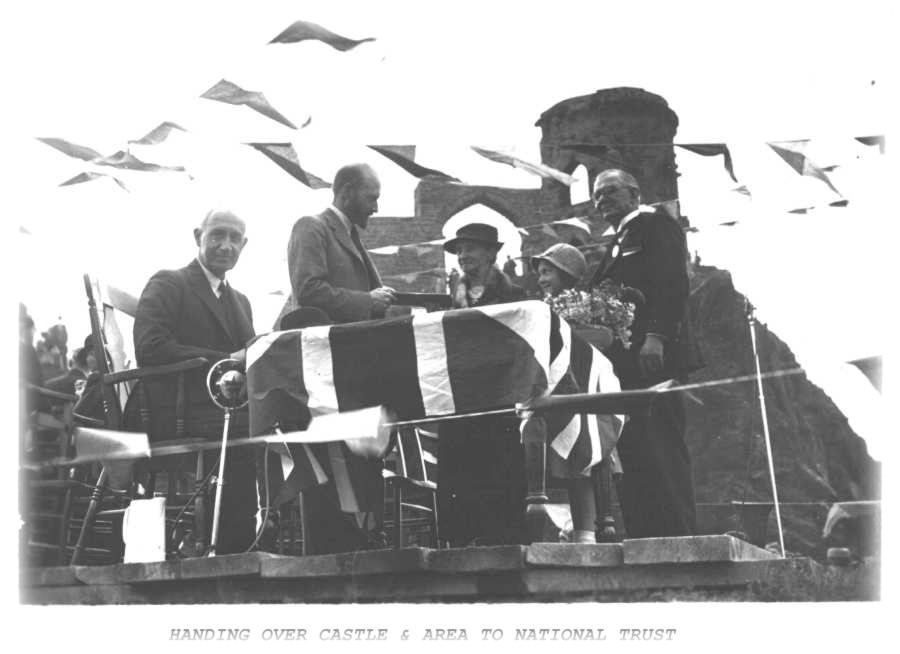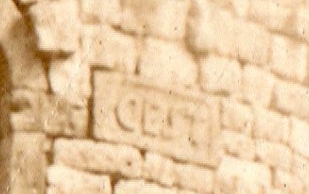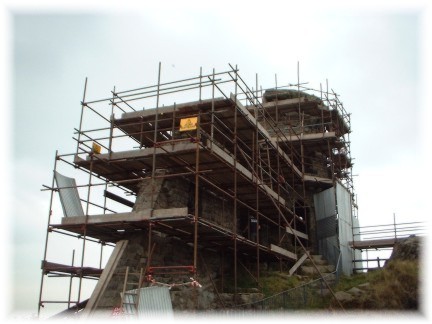
Castle
Mow Cop Castle, a familiar site to everyone
who has lived in the area during the past 250 years.
But who built it? And Why?
Some have suggested that the Romans built a beacon or watchtower on this site
during their occupation of England. This idea is be supported by the fact
that the Romans had a small camp at Bent Farm, Astbury. The Romans did build
a road from Bent Farm through to Biddulph via the ‘Nick O Th Hill’
this would have bought them very close to Mow Cop. There is coal, millstone
grit, and limestone in the area, all of which the Romans would have used.

The A34 which itself was Roman could
have been watched over easily from a tower on the top of the hill. All this,
however, is speculation, and there is no hard physical evidence of Roman occupation.
If there was it would have been destroyed with the many years of quarrying
and mining.
Accepted now is the following account of who built Mow Cop Castle.
The Castle was built as a summerhouse in 1754 for Randle Wilbraham I of Rode Hall. It was built to look like part of a castle of a bygone era, and would have enhanced the view of the newly constructed Rode Hall some 3 miles away on the Cheshire side of the hill. Mr. Wilbraham employed local stonemasons John and Ralph Harding. It is said they were paid 1 shilling a day, and one of the members of the family lost a hand while constructing the castle. The Wilbraham family used the summerhouse for picnics and entertaining friends on days out. In the early part of the 19th century, Miss Wilbraham wrote.
"We have always
believed the family tradition, that towards the end of the 18th
century, the Wilbraham then resident at Rode Hall built the tower. The wall
was always broken so as to have effect off a ruin when looked at from the
valley."
She also wrote:
" We were accustomed to boil our kettle and have tea in it on calm
days..."
In the mid 1800’s, a row over the
summerhouse started between Randle Wilbraham and Ralph
Sneyd of Keele Hall. Sneyd claimed that part of the summerhouse
was built on his land, and that part ownership should fall to him. What followed
was a court case, presided over by Mr.
Justice Patteson of Staffordshire in the year 1850.
Luckily neither of them needed personal
injury lawyers to help with their case.
At the turn of the 19th century, the Wilbraham family moved up
to Lancashire and when they returned some 50 years later the summer house
had fell into a bad state. The upper floor and stairs along with the doors
had gone, and so they set about restoring the house to it’s former glory,
with windows and doors so that it may be used again.
The court also heard that while the Wilbraham family had been away, Gordon
Reece, a steward for Mr. Wilbraham, had maintained the summerhouse as an ornamental
ruin.
Reece told the court that in 1824 part of the walls had been restored and
the door replaced at a cost of £4 4s. It was also worked on in 1841, however
it wasn't until the family returned that the full restoration had taken place,
at a cost of £34. Up until this point the house was open to the public, but
was locked up after renovation.
"Soft as velvet to the feet", had been washed away. At about this time, the postmaster off Scholar Green. Mr. G H Morris decided to measure the castle and archway.
| Circumference | 65 ft 9" |
| Diameter | 20 ft 9" |
| Doorway Height | 7 ft 9" |
| Doorway Width | 3 ft 2" |
| Thickness of Wall | 3 ft 2" |
| Windows Width | 4 ft |
| Height of Tower | 32 ft 9" |
In 1923 the castle
and all the surrounding lands (including the Old Man O’Mow) were purchased
from the Late Sir Philip Baker-Wilbraham and the Bishop of Derby,
who were the Lords of the Manor on the Cheshire side, for the purpose of quarrying,
by a Mr. Joe Lovatt
What followed was a bitter legal wrangle lasting up until 1935.
The land and the castle had been commonly used for many years, and people from near and far were furious that firstly the land had been sold, and secondly that is was to be quarried. Joe Lovatt offered the Castle and a ½ acre of land for public use, if the public would repair the castle. The offer was refused, as the people firmly believed that no one had a right to quarry the land they had used for many years. Joe Lovatt carried about his business and many thousand of tons of rock were removed, including all the old stone heaps that had built up over the years. The people backed by their MP formed the Mow Cop preservation committee. In September 1923 a meeting of 500 protesters and 50 committee members marched on the quarry and pulled down loose stone walls, wire fences and even up turned a stone crusher. It was done in a civilised manner, and as time went by, the crowds got less, the committee’s changed and many solicitors’ letters went back and forth.

Eventually the quarrying stopped and in the month of June 1937, the deeds for the Castle and surrounding lands were handed over to the National Trust, in front of a large crowd, as in the picture on the left. The saga had come to an end. The castle was repaired to its present day condition, with a large V shaped section missing where one of the windows had collapsed, and a large section of the buttress wall missing. One has to ask the question however why did that part of the castle collapse. One theory offered was that it was caused by the vibration of quarrying work, another explantion was offered that it fell on its own at the end of WW1 as a V for victory.
There was in the Castle a large stone with the letters CEST carved into it. Just what the inscription means I as yet do not know. The stone was coincidentaly in the position where the alleged collapse took place. Did a stone mason or any one else for that matter decide they would like that stone for another job. If anyone sees a large stone in the area or in fact anywhere with CEST on I would be interested to here from them. More work was carried out in 1999 when National Trust decided to protect people from themselves and make sure no one could enter the Castle and sit in the windows and fire place, iron bars were added and large iron gate door was padlocked shut.

At the end of August 2002 scaffolding
started to go up around the castle, the process has taken over 4 weeks, this
time scale is easily justified when you consider the amount of scaffolding
required and the location to which it has to be carried.
The purpose is the reinforce the foundations which have become exposed and
weak, and to point up the brickwork making the castle a safe place to visit
once again.
I have been informed by National Trust Property Manager, Paul Rutter that
the entire project is costing £80 000, the work is being undertaken
by Cheshire Masonry. By Jan 2003 the work of repairing the Castle had been
finished and the picture on the left was taken the week the scaffolding was
removed, as you can see the Castle has been pointed up well. There are a few
bands of lighter mortar, this is where the reinforcing has been added; also
on the arch are new anti climbing spikes.
